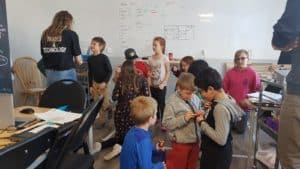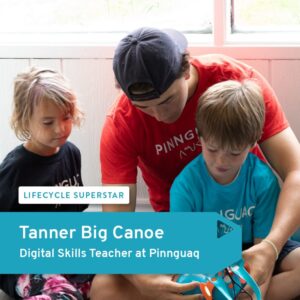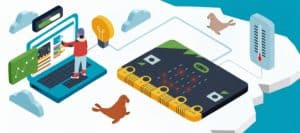Sewing and beading provide both practical and creative opportunities for cultures, over millennia, to clothe communities, engage in ceremony, as well as trade with others. Through Pinnguaq’s Stitches and Switches Sewing and Technology Kit, we provide users an opportunity to explore science, technology, engineering, art and math (STEAM) while designing textile resources.
Through these kits, educators have an opportunity to share culturally-specific teachings, such as the Inuit value of Pijitsirniq/Piliriqatigiingniq;serving and providing for our family and community, and working together for that goal. The activities in the Stitches and Switches Sewing and Technology Kits incorporate elements of Inuit Qaujimajatuqangit, while exploring the ways in which types of technology can benefit our everyday lives.
Through the kits,” explains Mary McDonald, a digital skills educator and artist with Pinnguaq, “participants explore their roles in the community by learning new digital skills.” McDonald has seen the ways in which the kits are creative and engaging, helping participants build personal connections between the interest in sewing and beading and new technology skills. “With these kits, creators can let their imaginations for innovation in textiles soar.”
Background
The Stitches and Switches Sewing and Technology Kit was inspired by the sewing skills and interests of the students at Ulluriaq School in Kangiqsualujjuaq when the Pinnguaq team visited the community. Students were creating beautiful parkas and other clothing. The team was inspired to develop a STEAM kit that would compliment the students’ skills and make meaningful connections for them and of course, be fun! Recently, the kits were used with participants at the Tree of Peace Friendship Centre in Yellowknife, NT, and shared with a Girls’ Empowerment group headed by Ilitaqsiniq Nunavut Literacy Council.
“Inuit children have always been expected to serve others willingly. Serving means doing something for someone else. This is taught throughout childhood. Inuit have always been encouraged to be good servants to others. Serving a neighbour often meant offering something for them to use. This involves a forward-thinking vision, recognizing that the benefit of sharing what one has available may not come immediately but rather later, when it is needed. Ongoing, genuine concern for other people is a way of life. Serving others means to lead others with a vision that will benefit your neighbour through putting aside your own interests for the sake of helping someone else.” writes Shirley Tagalik, on Inuit Principles of Conservation.
Teachings about sewing and beading in cultural contexts are often passed down from community Elders and knowledge holders, including grandmothers, mothers, and aunties. For instance, in the North, online social communities such as Arctic Sewing Room continue to demonstrate exquisite craftsmanship in amauti, parka, mittens, jewelry, mukluks, kamiks, and more. Sharing of knowledge and textile resources benefits community resilience against climate change and colonization.
Kit Contents
- LilyPad E-Sewing Kit (needles, conductive thread, and electronic components)
- Lily-Tiny (to make lights twinkle, flash, and fade)
- Extra Lilypad LED lights (designed for sewing)
- Extra batteries, wires, electronic components, conductive tape
- Conductive and regular fabric
- Beading needles and beads
- Flash drive with activity booklet with 7 activities and resources
- Root & STEM Magazine
Activities
The kits include a number of resources for the learners, as well as fun, educational and engaging activities to try.
Through the activities, participants will learn about sewing the LilyPad into the fabric with conductive wire to build an electrical circuit that makes lights turn on and off. The kit offers knowledge about series and parallel circuits that help to integrate different types of light patterning. Through a beading activity, kit users will learn how to make beaded patches that integrate lighting. As a final project, participants will develop a felt scene for storytelling that integrates technology for a magical result!
The LilyPad technology was designed by Leah Buechley, a Ph.D. student studying computer science in Colorado, US.
The LilyPad is a sewable electronic device for e-textile (electronic textile) design. This kit includes conductive thread and fabric that replaces traditional wiring for electronics. This kit does not require computers or coding support; learning goals focus on sewing skills and understanding circuits.
A guidebook included in the kit helps participants learn how to use their LilyPad.
The kit also includes activities that address climate change through activities and reflections through a partnership with the Climate Collective, a project run by Memorial University’s Johnson Geo Centre. Participants will be guided through questions about the ways in which textile art can tell a story about climate impacts on traditional ways of harvesting materials and creating textiles for everyday use and art.
Additional Resources
Want to explore more resources like this? Check out our Learning on the land Environmental Stewardship Kit.
Explore the Spirit Berries article and the art of Barry Ace in Issue #1 of Root and STEM Magazine.
Other lesson plans include:
- Build an Aquafier
- Create a Water Filter with Recycled and Natural Materials
- Mshkiigwaatikohns Tea! Traditional Nerve Medicine
- Planting Traditional Medicine: Semaa; Oien’kwa’ón:we
- Stick Puzzlers
- Recycled Marble Maze
- How to Construct a Bee Hotel and Lesson Plan
- Polyculture: Traditional Haudenosaunee Kionhekwa Garden
- Creating Art Inspired by Traditional Métis Dot Art



